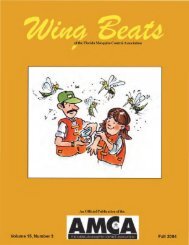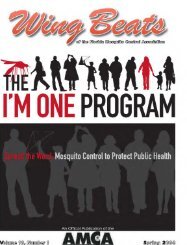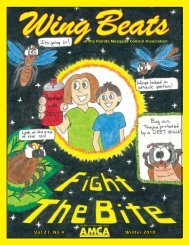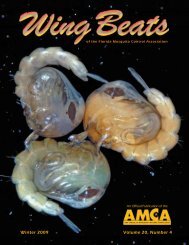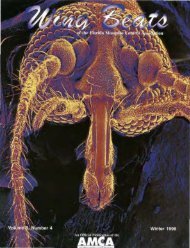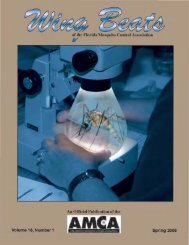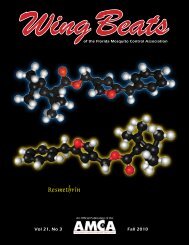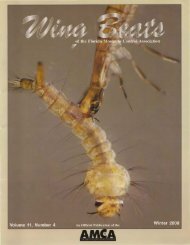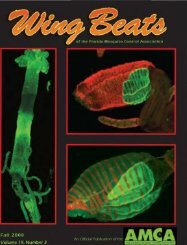Volume 23 Number 1 - Wing Beats - Wing Beats - Florida Mosquito ...
Volume 23 Number 1 - Wing Beats - Wing Beats - Florida Mosquito ...
Volume 23 Number 1 - Wing Beats - Wing Beats - Florida Mosquito ...
Create successful ePaper yourself
Turn your PDF publications into a flip-book with our unique Google optimized e-Paper software.
12<br />
family Corethrellidae, similar defensive<br />
motions are used against<br />
mosquitoes.<br />
Do these challenges result in<br />
similarities among the frogbiting<br />
mosquito species? Several<br />
generalities can be suggested.<br />
First, frog-biting diptera tend to be<br />
nocturnal. There are exceptions,<br />
such as the biting ceratopogonid<br />
midge Forcipomyia fairfaxensis,<br />
but the majority of flies which are<br />
known to feed regularly on frogs<br />
are active at night. This is not<br />
too surprising, since most frogs<br />
and toads are also active and<br />
calling at night. This is the time<br />
when these hosts are easiest to<br />
detect. Secondly, the frog-biting<br />
species discussed here all spend<br />
their larval stages in ground pools<br />
rather than container habitats.<br />
This may increase contact with<br />
frog hosts and in Cx territans,<br />
larval habitat has been shown to<br />
be closely correlated with host<br />
presence (Bartlett-Healy et al,<br />
2008b). A final similarity among<br />
frog-biting species is small body<br />
size. The genus Uranotaenia<br />
includes some of the smallest<br />
mosquitoes of any genus and<br />
the subgenus Melanoconion<br />
includes some of the smallest<br />
of the Culex. Even Cx territans<br />
is a fairly small Culex mosquito,<br />
although not as small as these<br />
other groups. In parasite biology,<br />
Harrison’s rule states that parasite<br />
body size tends to correlate to<br />
host size such that larger hosts<br />
have larger parasites. Examples<br />
are seen in insects that are<br />
closely associated with their<br />
host such as lice, fleas and<br />
flower thrips (Kirk, 1991). Although<br />
mosquitoes do not live on their<br />
host, sufficient host interaction<br />
may occur to select for body<br />
size. The frog’s combination of<br />
relatively small body size and<br />
good defensive abilities may<br />
favor mosquitoes having a small,<br />
agile body for successful blood<br />
feeding.<br />
There is much to be learned from<br />
<strong>Florida</strong>’s frog-biting mosquitoes.<br />
The ability to observe natural<br />
mosquito-host interactions is a<br />
great opportunity that could<br />
lead to discoveries applicable<br />
to other hosts which are more<br />
difficult to observe directly. The<br />
importance of ectotherms as<br />
disease reservoirs is receiving<br />
increased attention leading to<br />
questions about the habits of<br />
the biting flies which feed on<br />
them. And, if nothing else, there<br />
is a fascinating story behind the<br />
lives of these small, secretive<br />
mosquitoes.<br />
REFERENCES CITED<br />
Bartlett-Healy K, Crans W &<br />
Gaugler R. 2008a. Phonotaxis to<br />
amphibian vocalization in Culex<br />
territans (Diptera: Culicidae).<br />
Ann Entomol Soc Am 101(1):<br />
95-103.<br />
Bartlett-Healy K, Crans W &<br />
Gaugler R. 2008b. Temporal<br />
and spatial synchrony of Culex<br />
territans (Diptera: Culicidae) with<br />
their amphibian hosts. J Med<br />
Entomol 45: 1031-1038.<br />
Borkent A & Belton P. 2006.<br />
Attraction of female Uranotaenia<br />
lowii (Diptera: Culicidae) to frog<br />
calls in Costa Rica. Can Entomol<br />
138: 91-94.<br />
Burkett-Cadena ND, Graham SP,<br />
Hassan HK, Guyer C, Eubanks<br />
MD, Katholi CR, Unnasch TR.<br />
2008. Blood feeding patterns<br />
of potential arbovirus vectors<br />
of the genus Culex targeting<br />
ectothermic hosts. Am J Trop<br />
Med Hyg 79: 809-815.<br />
Cupp EW, Zhang D, Yue X,<br />
Cupp MS, Guyer C, Sprenger TR,<br />
Unnasch TR. 2004. Identification<br />
of reptilian and amphibian<br />
blood meals from mosquitoes<br />
in an eastern equine encephalomyelitis<br />
virus focus in<br />
Spring 2012 <strong>Wing</strong> <strong>Beats</strong><br />
central Alabama. Am J Trop<br />
Med Hyg 71: 272-276.<br />
Edman JD. 1979. Host-feeding<br />
patterns of <strong>Florida</strong> mosquitoes<br />
(Diptera: Culicidae). VI. Culex<br />
(Melanoconion). J Med Entomol<br />
15: 521-525.<br />
Kirk, WDJ. 1991. The size relationship<br />
between insects and<br />
their hosts. Ecol Entomol 16:<br />
351-359.<br />
Larrick S, Blosser EM & Connelly<br />
CR. “Culex (Melanoconion)<br />
iolambdis Dyar” Featured<br />
Creatures. Ed. Thomas R Fasulo.<br />
2010. University of <strong>Florida</strong>. 3 Feb<br />
2012 .<br />
Tamashiro M, Toma T, Mannen<br />
K, Higa Y & Miyagi I. 2011.<br />
Bloodmeal identification and<br />
feeding habits of mosquitoes<br />
(Diptera: Culicidae) collected<br />
at five islands in the Ryukyu<br />
Archipelago, Japan. Med<br />
Entomol Zool 62: 53-70.<br />
Erik M Blosser<br />
PhD Student<br />
eblosser@ufl.edu<br />
L Philip Lounibos<br />
Professor<br />
lounibos@ufl.edu<br />
<strong>Florida</strong> Medical<br />
Entomology Laboratory<br />
Institute of Food and<br />
Agricultural Sciences<br />
University of <strong>Florida</strong><br />
200 9th Street SE<br />
Vero Beach, FL 32962<br />
772-778-7200



